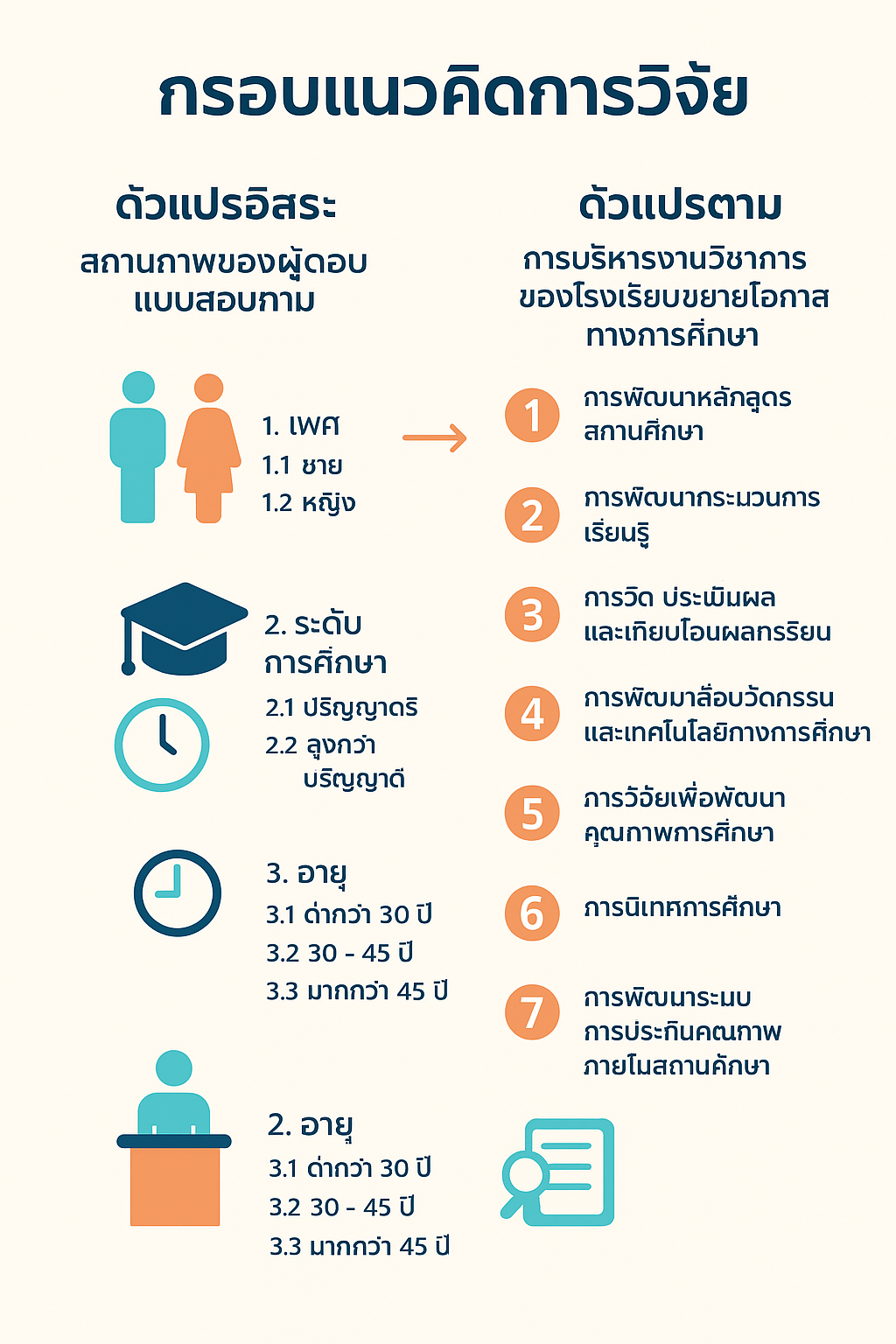Academic Administrtion of Opportunty Expansion Schools Under Suphanburi Primary Educational Service Area 2
Keywords:
Academic Administration, Opportunity Expansion School, under the Office of the Basic Education CommissionAbstract
This research aimed to 1) study the academic administration of the schools for expanding educational opportunities and 2) compare the academic administration of the schools for expanding educational opportunities in seven areas: curriculum development, learning process development, measurement, evaluation and transfer of learning outcomes, development of innovative media and educational technology, research for improving educational quality, educational supervision, and development of internal quality assurance systems in educational institutions, classified by gender, education level, and age. This research was quantitative. The sample consisted of 145 teachers of the schools for expanding educational opportunities. The research instruments were a questionnaire for general information of the respondents and a checklist for personal status. The academic administration variables were measured using a 5-point Likert scale with a reliability of 0.87.
The research results revealed that: 1) Academic administration of schools for expanding educational opportunities was at a high level overall. When considering each aspect, the highest to lowest average scores were: curriculum development, followed by learning process development, innovative media and educational technology development, measurement, evaluation and transfer of learning outcomes, educational supervision, quality assurance system development, and research for educational quality development. 2. The results of comparing academic administration of schools for expanding educational opportunities showed that teachers of different genders, educational levels, and ages had no significant differences in overall academic administration performance at the 0.05 level.
References
กระทรวงศึกษาธิการ. 2546. พระราชบัญญัติระเบียบบริหารราชการกระทรวงศึกษาธิการ
พ.ศ.2546 และ กฎกระทรวงแบ่งส่วนราชการ. กรุงเทพฯ : องค์การรับส่งสินค้าและ
พัสดุภัณฑ์ (ร.ส.พ.).
ขวัญใจ สุขยงค์ (2559).การบริหารวิชาการของโรงเรียนขยายโอกาสทางการศึกษา สังกัดสานักงานเขตพื้นที่ การศึกษาประถมศึกษานครปฐม เขต 13 การศึกษาค้นคว้าอิสระบัณฑิตศึกษา การบริหารการศึกษา, มหาวิทยาลัยปทุมธานี.
จรุณี เก้าเอี้ยน (2556) เทคนิคการบริหารงานวิชาการในสถานศึกษา กลยุทธ์และ แนวทางการปฏิบัติสำหรับผู้บริหารมืออาชีพ. (พิมพ์ครั้งที่ 2) สงขลา: ชานเมืองการพิมพ์.
จิรชยา ชัยมลล์.(2561).การศึกษาการบริหารงานวิชาการของโรงเรียนขยายโอกาสทางการศึกษาในอำเภอนาจะหลวย จังหวัดอุบลราชธานี การศึกษาค้นคว้าอิสระบัณฑิตศึกษาการบริหารการศึกษา วิทยาลัยเทคโนโลยีสยาม.
ภารดี อนันต์นาวี. (2557). ปัจจัยทีส่งผลต่อการตัดสินใจเลือกเข้าศึกษาต่อสาขาวิชาการบริหารการศึกษา
ศูนย์นวัตกรรมการบริหารและผู้นำทางการศึกษา,คณะศึกษาศาสตร์ มหาวิทยาลัยบูรพาวารสาร
วิชาการ ศรีปทุม ชลบุรี, 10(4), .20-129.
มะโน สีทอง.(2554)การบริหารงานวิชาการของโรงเรียนที่จัดการศึกษาช่วงชั้นที่1-2ในอำเภอตะกั่วป่าจังหวัดพังงา.วิทยานิพนธ์ลักสูตรศึกษาศาสตรมหาบัณฑิต สาขาการบริหารการศึกษา บัณฑิตวิทยาลัย มหาวิทยาลัยราชภัฏสวนดุสิต.
รุ่งชัชดาพร เวหะชาติ.(2552.) การบริหารงานวิชาการสถานศึกษาขั้นพื้นฐาน.พิมพ์ครั้งที่ 3. สงขลา
คณะศึกษาศาสตร์ มหาวิทยาลัยทักษิณ.
สำนักงานคณะกรรมการการศึกษาขั้นพื้นฐาน.(2552). คู่มือการปฏิบัติงานราชการครู. กรุงเทพฯ: ชุมนุมสหกรณ์การเกษตรแห่งประเทศไทย.
สันติ บุญภิรมย์. (2553). การบริหารงานวิชาการ. (พิมพ์ครั้งที่ 2). กรุงเทพฯ: บุ๊ค พอยท์.
สุมน อมรวิวัฒน์.(2536). หลักและแนวปฏิบัติในโรงเรียนระถมศึกษา. กรุงเทพฯ: ไทยวัฒนาพานิช.
Krejcie, R. V. & Morgan, D. W. (1970). Determining Sample Size for Research Activities.
Educational and Psychological Measurement, 30(3), pp. 607-610.

Downloads
Published
How to Cite
Issue
Section
License
Copyright (c) 2025 Vol. 1, No. 2 (May-August) 2025

This work is licensed under a Creative Commons Attribution-NonCommercial-NoDerivatives 4.0 International License.
This article is published under a Creative Commons Attribution-NonCommercial-NoDerivatives 4.0 International License (CC BY-NC-ND 4.0), which allows others to share the article with proper attribution to the authors and prohibits commercial use or modification. For any other reuse or republication, permission from the journal and the authors is required.

